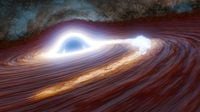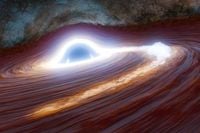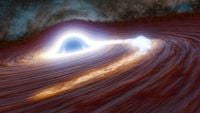In a cosmic spectacle that has left astronomers in awe, a supermassive black hole at the heart of a distant galaxy has set a new record for the brightest and most powerful black hole flare ever observed. The event, documented in a study published on November 4, 2025, in Nature Astronomy, has not only rewritten the record books but also challenged longstanding assumptions about the behavior of black holes in the universe.
The story of this extraordinary discovery began in 2018, when the Zwicky Transient Facility (ZTF)—a sky survey funded by the US National Science Foundation and based at Caltech’s Palomar Observatory—first noticed a “particularly bright object” in the night sky. At the time, follow-up observations revealed little more than its unusual luminosity. But as the years passed, the cosmic phenomenon, now known as J2245+3743, continued to intrigue scientists.
According to Space.com and NBC News, the flare originated from an active galactic nucleus (AGN) located a staggering 10 billion light-years from Earth. The supermassive black hole at the center of this AGN is estimated to be 500 million times the mass of our Sun—a true behemoth in the cosmic landscape. What set this flare apart was not just its distance, but its sheer brightness: at its peak, it shone with the light of 10 trillion suns, making it 30 times more luminous than any previous black hole flare ever recorded.
“This is really a one-in-a-million object,” said Matthew Graham, lead author of the study and research professor of astronomy at the California Institute of Technology, as quoted by NBC News. Graham, who also serves as a project scientist for ZTF, emphasized just how unprecedented the event was: “This is unlike any AGN we’ve ever seen.”
The flare’s dramatic rise—brightening by a factor of 40 over just a few months—caught the attention of astronomers worldwide. Yet, it wasn’t until 2023, when distance measurements from the W. M. Keck Observatory in Hawaii were obtained, that the full scale of the event became clear. “Suddenly it was: ‘Oh, this is actually quite far away,’” Graham recalled. “And if it’s that far away and it’s this bright, how much energy is being put out? This is now something unusual and very interesting.”
The cause of this celestial outburst? Researchers concluded the most likely explanation was a tidal disruption event (TDE)—a rare cosmic catastrophe in which a star ventures too close to a black hole and is torn apart by its immense gravitational forces. In this case, the doomed celestial body, playfully dubbed the “interstellar Icarus,” was no ordinary star. According to the study co-authored by Borough of Manhattan Community College (BMCC/CUNY) astronomy professors K. E. Saavik Ford and Barry McKernan, the star was at least 30 times the mass of our Sun, making it the most massive star ever seen shredded by a supermassive black hole.
“This is probably the most massive star ever seen shredded by a supermassive black hole,” Professor Ford told BMCC/CUNY. “That’s exciting because it tells us that massive stars must live in and around gas disks around super-massive black holes.” She further explained the sheer scale of the energy involved: “If you convert our entire Sun to energy, using Albert Einstein’s famous formula E = mc², that’s how much energy has been pouring out from this flare since we began observing it.”
The ongoing nature of the flare has only deepened the mystery. Unlike typical flares, which burn bright and fade quickly, J2245+3743 has been shining for around seven years—and counting. Yet, its light is gradually fading, suggesting the black hole is still in the process of devouring the star. Graham likened the phenomenon to “a fish only halfway down the whale’s gullet.”
What makes this event even more fascinating is the phenomenon of cosmological time dilation. Because the flare is so far away, and the universe is expanding, time at the site of the black hole actually runs slower compared to Earth. “Seven years here is two years there. We are watching the event play back at quarter speed,” Graham explained to BMCC/CUNY, highlighting the importance of long-term sky surveys like ZTF and the Catalina Real-Time Transient Survey in capturing the full evolution of such rare cosmic events.
The discovery of J2245+3743 has also shed new light on the environments around supermassive black holes. Most of the roughly 100 TDEs observed to date have not occurred in AGNs—galactic centers with swirling disks of gas and dust feeding the central black hole. AGNs typically flare up with their own feeding activity, making it difficult to spot TDEs. But the sheer scale of this event made it impossible to miss. “Stars this massive are rare,” Ford noted, “but we think stars within the disk of an AGN can grow larger. The matter from the disk is dumped onto stars, causing them to grow in mass.”
To confirm the nature of the flare, the research team systematically ruled out other possible explanations. Supernovae, for instance, were deemed far too dim to account for the observed brightness. The possibility that the object was simply beaming light toward Earth was also discounted, thanks to data from NASA’s former Wide-field Infrared Survey Explorer (WISE) mission. Ultimately, the evidence pointed squarely to an ongoing tidal disruption event of unprecedented magnitude.
The previous record holder for a TDE, an event nicknamed Scary Barbie, was not nearly as intense. That flare, also thought to have originated from an AGN, involved a star estimated at just three to ten solar masses and was 30 times weaker than J2245+3743.
As for what comes next, the research team is far from finished. “We never would have found this rare event in the first place if it weren’t for ZTF,” Graham said, underscoring the value of continuous monitoring. The team plans to mine more data from ZTF and anticipates future discoveries from the upcoming Vera C. Rubin Observatory, which may reveal even more colossal cosmic feasts.
The study, titled “An Extremely Luminous Flare Recorded from a Supermassive Black Hole,” was supported by the National Science Foundation, the Simons Foundation, NASA, and the German Research Foundation. It brought together a global collaboration of astronomers from institutions including Caltech, BMCC/CUNY, the CUNY Graduate Center, Princeton University, UC Berkeley, the University of Southampton, and others.
For students and science enthusiasts, the discovery offers a vivid example of how patient observation, rigorous analysis, and a bit of cosmic luck can lead to groundbreaking insights. As Professor McKernan put it to his students, “The cool thing about this work is it took a lot of detective work to figure out what we can rule in and rule out. We end up in a really cool place, the most energetic flare ever seen as a supermassive black hole tears apart a massive star.”
As the light from J2245+3743 continues its journey across the cosmos, astronomers remain vigilant, eager to see what other secrets these celestial giants might reveal. The universe, it seems, is far more dynamic—and surprising—than anyone had imagined.






